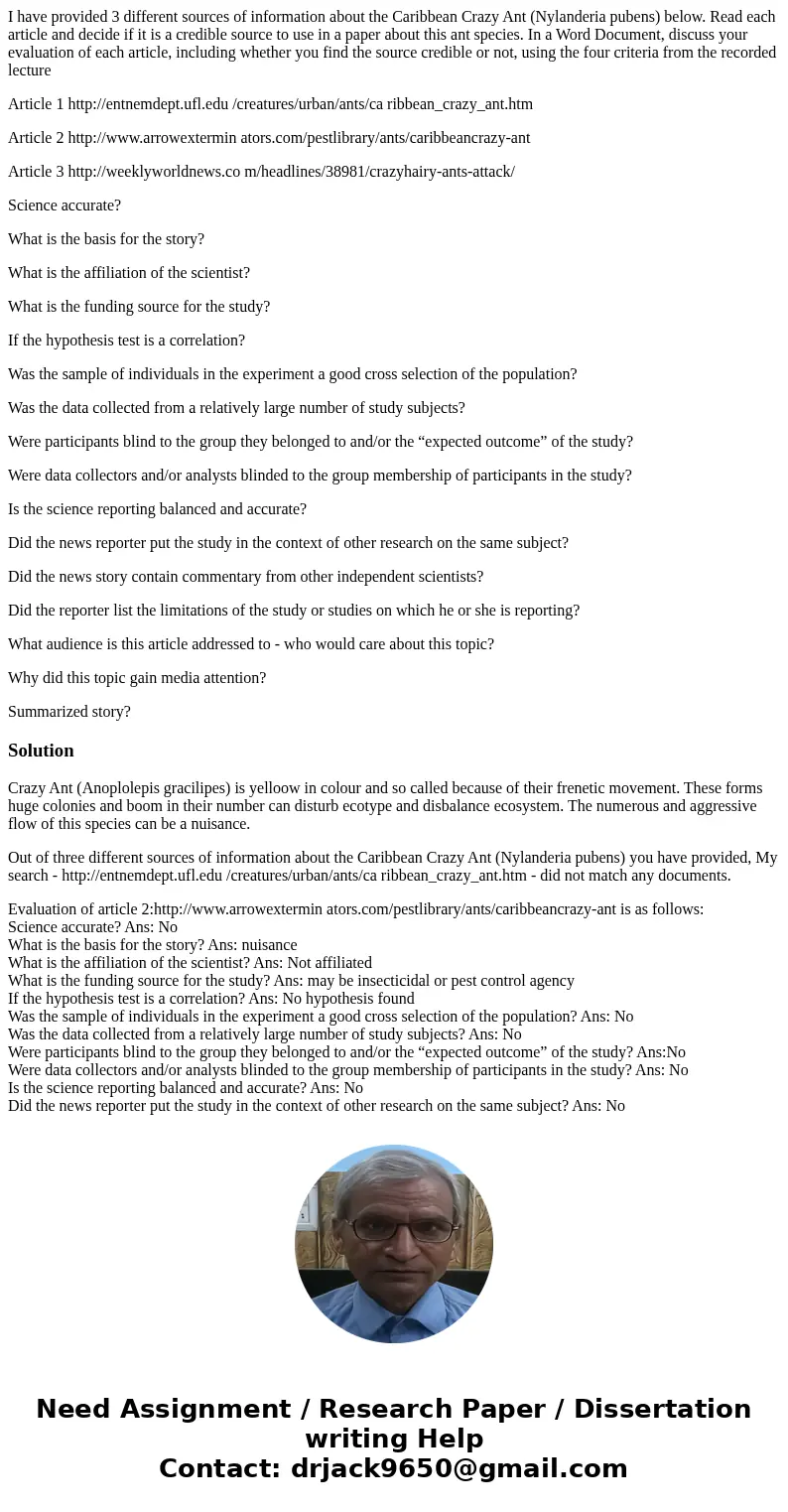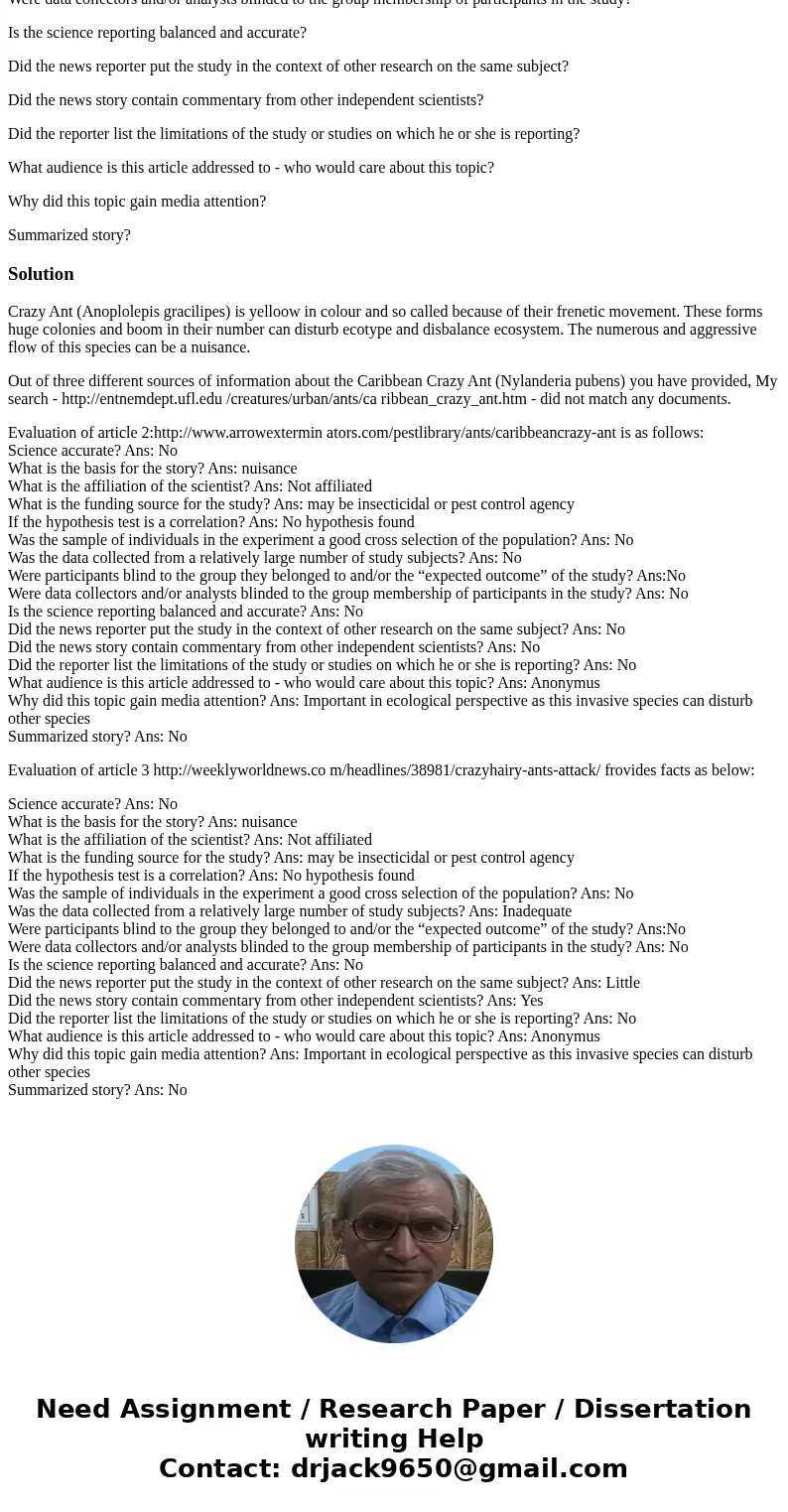I have provided 3 different sources of information about the
I have provided 3 different sources of information about the Caribbean Crazy Ant (Nylanderia pubens) below. Read each article and decide if it is a credible source to use in a paper about this ant species. In a Word Document, discuss your evaluation of each article, including whether you find the source credible or not, using the four criteria from the recorded lecture
Article 1 http://entnemdept.ufl.edu /creatures/urban/ants/ca ribbean_crazy_ant.htm
Article 2 http://www.arrowextermin ators.com/pestlibrary/ants/caribbeancrazy-ant
Article 3 http://weeklyworldnews.co m/headlines/38981/crazyhairy-ants-attack/
Science accurate?
What is the basis for the story?
What is the affiliation of the scientist?
What is the funding source for the study?
If the hypothesis test is a correlation?
Was the sample of individuals in the experiment a good cross selection of the population?
Was the data collected from a relatively large number of study subjects?
Were participants blind to the group they belonged to and/or the “expected outcome” of the study?
Were data collectors and/or analysts blinded to the group membership of participants in the study?
Is the science reporting balanced and accurate?
Did the news reporter put the study in the context of other research on the same subject?
Did the news story contain commentary from other independent scientists?
Did the reporter list the limitations of the study or studies on which he or she is reporting?
What audience is this article addressed to - who would care about this topic?
Why did this topic gain media attention?
Summarized story?
Solution
Crazy Ant (Anoplolepis gracilipes) is yelloow in colour and so called because of their frenetic movement. These forms huge colonies and boom in their number can disturb ecotype and disbalance ecosystem. The numerous and aggressive flow of this species can be a nuisance.
Out of three different sources of information about the Caribbean Crazy Ant (Nylanderia pubens) you have provided, My search - http://entnemdept.ufl.edu /creatures/urban/ants/ca ribbean_crazy_ant.htm - did not match any documents.
Evaluation of article 2:http://www.arrowextermin ators.com/pestlibrary/ants/caribbeancrazy-ant is as follows:
Science accurate? Ans: No
What is the basis for the story? Ans: nuisance
What is the affiliation of the scientist? Ans: Not affiliated
What is the funding source for the study? Ans: may be insecticidal or pest control agency
If the hypothesis test is a correlation? Ans: No hypothesis found
Was the sample of individuals in the experiment a good cross selection of the population? Ans: No
Was the data collected from a relatively large number of study subjects? Ans: No
Were participants blind to the group they belonged to and/or the “expected outcome” of the study? Ans:No
Were data collectors and/or analysts blinded to the group membership of participants in the study? Ans: No
Is the science reporting balanced and accurate? Ans: No
Did the news reporter put the study in the context of other research on the same subject? Ans: No
Did the news story contain commentary from other independent scientists? Ans: No
Did the reporter list the limitations of the study or studies on which he or she is reporting? Ans: No
What audience is this article addressed to - who would care about this topic? Ans: Anonymus
Why did this topic gain media attention? Ans: Important in ecological perspective as this invasive species can disturb other species
Summarized story? Ans: No
Evaluation of article 3 http://weeklyworldnews.co m/headlines/38981/crazyhairy-ants-attack/ frovides facts as below:
Science accurate? Ans: No
What is the basis for the story? Ans: nuisance
What is the affiliation of the scientist? Ans: Not affiliated
What is the funding source for the study? Ans: may be insecticidal or pest control agency
If the hypothesis test is a correlation? Ans: No hypothesis found
Was the sample of individuals in the experiment a good cross selection of the population? Ans: No
Was the data collected from a relatively large number of study subjects? Ans: Inadequate
Were participants blind to the group they belonged to and/or the “expected outcome” of the study? Ans:No
Were data collectors and/or analysts blinded to the group membership of participants in the study? Ans: No
Is the science reporting balanced and accurate? Ans: No
Did the news reporter put the study in the context of other research on the same subject? Ans: Little
Did the news story contain commentary from other independent scientists? Ans: Yes
Did the reporter list the limitations of the study or studies on which he or she is reporting? Ans: No
What audience is this article addressed to - who would care about this topic? Ans: Anonymus
Why did this topic gain media attention? Ans: Important in ecological perspective as this invasive species can disturb other species
Summarized story? Ans: No


 Homework Sourse
Homework Sourse